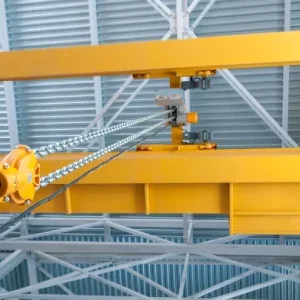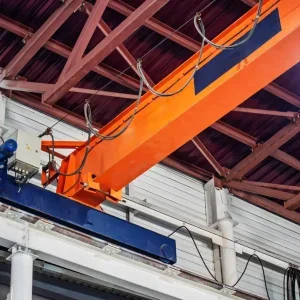You don’t need a weatherman to know which way the wind blows, was Bob Dylan’s opinion. I don’t think he was talking specifically about economists, and I am sure that to this very day Dylan has no particular views on the overhead crane industry (if any reader knows the great man personally, they might care to ask him for me) but there is one man who spends much of his time tracking every tiny twist and turn in the industry’s weather to predict where it is going and when it it will get there. If you are unsure about what’s going on in the US market place, then he’s the man to turn to.
Hal Vandiver is executive vice president of the Materials Handling Industry of America (MHIA) and is managing director of the three affiliated product sections most relevant to the overhead crane industry, namely the Crane Manufacturers Association of America (CMAA), the Hoist Manufacturers Institute (HMI) and the Monorail Manufacturers Association.
Armed with a Bachelors degree in economics and business, Vandiver started in the materials handling industry in the early 1970s as a market analyst for the Yale division of Eaton Corporation (as it was then) and by the age of 26 he was statistical chairman of the HMI. After a subsequent period working in the construction industry he rejoined the materials handling field in 1993 on the staff of the MHIA.
Now 52, his job – or at least the one that he is paid for – is running the trade associations. But his life, so it seems, is statistics, analysing trends and producing forecasts. There is surely no one in the industry quite as enthusiastic as Vandiver at taking the pulse of the industry. Vandiver describes crunching the numbers of the industry as his hobby, consuming whatever leisure time he has.
And the good news is that the US market is on the turn and set fair for recovery, according to Vandiver.
Actually that might be overstating the case a little bit. Vandiver says that the market has now bottomed out. The third quarter of 2002 will prove to have been the trough. Demand has ceased to decline, he confidently believes. “Whether we will see actual growth is not clear,” he adds cautiously.
Economists are famous for having predicted seven of the last five recessions, the saying goes, and there are those in the industry that treat even Vandiver’s predictions with a degree of cynicism. “He was saying we’d bottomed out six months ago,” one jaded hoist salesman told me. But given Vandiver’s experience, there are not many in the industry that are better placed to make sense of the where the US market might be heading.
Over the years, long run average growth in the US hoist, crane and monorail market has run at about 3% or 4%, mirroring industrial expansion, Vandiver can tell you. But in the period 1987 to 1999, when the US industrial base expanded rapidly, the hoist, crane and monorail market grew at an average rate of 6.5% a year and in some parts at up to 30%. The subsequent cyclical downturn in demand, which began in December 1998, was therefore perhaps inevitable.
He uses a wide range of indicators from which to make his forecasts, with the leading indicator being the Federal Reserve Board’s industrial production index, which ‘dropped precipitously’ in 2001/02.
Between 1992 and 1998 industrial capacity was added at a faster rate than ever before in the USA – “this, at least, is what government data indicates,” he adds. Since then, industrial capacity has been taken off line and utilisation of on line capacity has dropped.
Vandiver can pull up government statistics that show that wire rope hoists account for 23% of the US hoisting equipment market (about 20% electric powered and 3% pneumatic), that powered chain hoists account for nearly 20% (electric 13.6%, air 5.8%) and that 31% of the hoisting equipment market is components.
Similarly he can break down the cranes and monorails market into: parts and attachments – 18%; double girder top running cranes – about 24%; single girder top running cranes – 7%; under running cranes – 9%… and so on. Parts and attachments, incidentally, account for about 20% of this market.
All kinds of numbers about the market are available if you know where to look, Vandiver says. And a lot of it is posted on the MHIA’s own website (www.mhia.org).
US government figures show that US product shipments of hoists (SIC 35363 under the US standard industrial classification system) and overhead travelling cranes & monorails (SIC 35364) had a total value of about $1.14bn in 2000, down from a peak of $1.32bn in 1999.
US manufacturers of hoists, cranes and monorails usually export goods with a value in the region of $120m to $150m. This peaked in 1997 at $190m.
However, imports have exceeded exports in this market in the USA every year since 1994. The balance of imports and exports throughout the 1990s up until 1997 was in the region of plus or minus $50m. In the past few years, imports have outstripped exports by anything between $150m and $200m, peaking at $207.8m in 1998, no doubt due in large part to the strength of the dollar making life hard for US exporters.
“Historically, net imports have been about 1.5% of consumption,” Vandiver says. “Since 1998, it’s been 11%.” In 2000 US manufacturers produced 77% (by value) of the hoists, cranes and monorails that were consumed in the USA. Back in 1989 the figure was 86%, and the ratio peaked in 1991 at 91.4%.
The size of the US market can be derived from the domestic production figures and the trade deficit figures. In 2000 the balance of net imports was $157m, which added to the $1.1bn of US produced goods, gives a total US market size of about $1.25bn in 2000.
Vandiver introduces a note of caution about the reporting of certain products. It is not always clear in these days of globalisation, cross-border ownership and outsourcing to define exactly what is an import and what is an export. With this in mind, he treats all numbers carefully.
For example, he doesn’t rely solely on government figues, which it seems are filled with quirks of imprecision. Among the reasons for suspecting the absolute accuracy of government numbers is the fact that for four years out of five they are based on sample surveys and only every five years (years ending in 2 and 7) are they adjusted by taking an economic census. There also might be some parts and components that are shipped and don’t always end up being listed in the column that this industry would regard as the most relevant or logical. Consequently, Vandiver refines the government data with information supplied my HMI, CMAA and MMA members using what he calls “my particular insight into the industry”.
The end result is not hugely different but does explain why any numbers you may hear Vandiver citing do not exactly tally with the government numbers published on the MHIA website and on these pages. Vandiver, for example, puts 1999 US production at $1.412bn and 2000 at $1.206bn. In 2001 production fell a dramatic 20% to almost exactly $1bn. He does not yet know – one presumes that he will soon – what the value of net imports was last year, but assuming it is around the level of previous years, that puts the value of the total 2001 US hoist, crane and monorail market at about $1.3bn.
Don’t need a weatherman?






